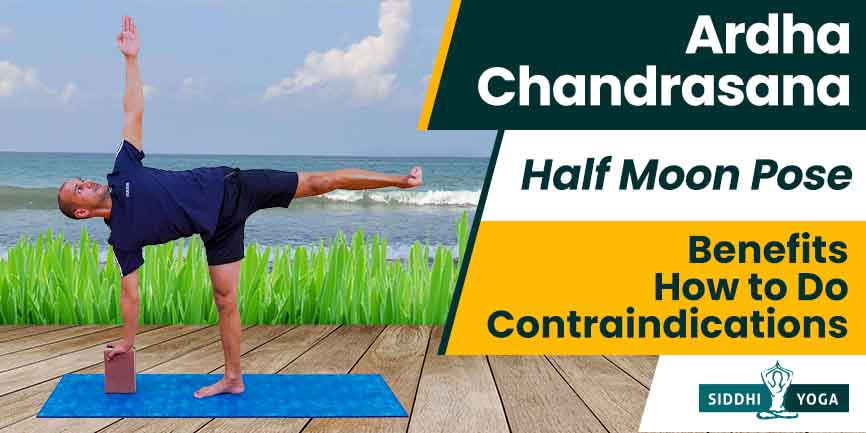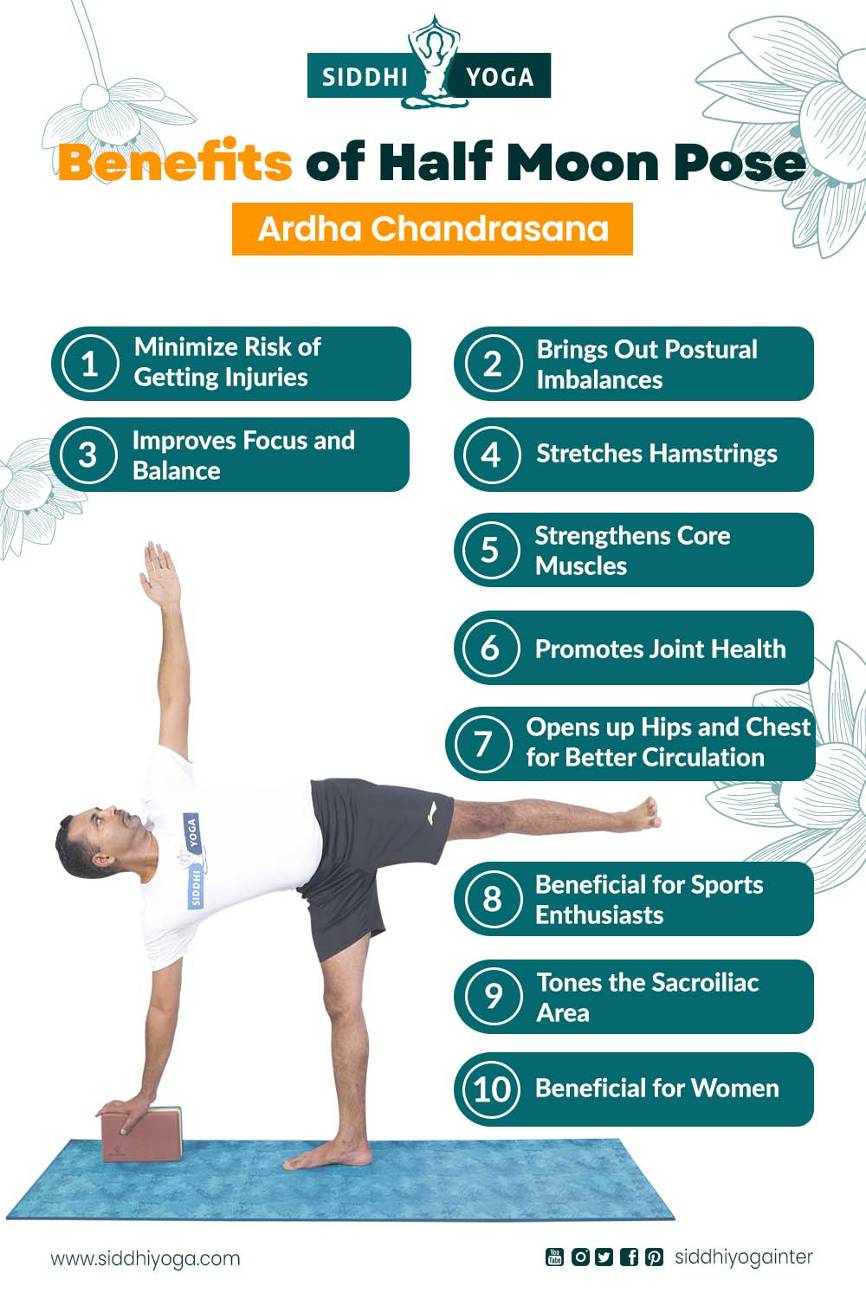
Chandra: Moon
Asana: Pose
Ardha Chandrasana at a Glance
Ardha Chandrasana or the Half-Moon Pose is the standing balancing pose on one leg and involves, a sense of balance and coordination. Ardha Chandrasana originated from, Hatha yoga. Ardha Chandrasana is the only Hatha Yoga (Ha=Sun & Tha=Moon) pose that brings out both energies. Half Moon means, the other half is considered – Half Sun, so this beautiful pose balances both the hot and cold energies.
Benefits:
- It helps to strengthen your buttocks, thighs, and spine.
- It helps to strengthen your abdominal muscles.
- It helps to stretch and open your chest and shoulders.
- It helps to balance your body and mind.
- Balancing and coordination in this asana helps to improve your self-confidence.
Who can do it?
Individuals already practicing asanas can do this asana. Intermediate to Advanced level yoga practitioners can do Ardha Chandrasana. People with strong core and balance can practice this pose. Individuals who want to improve their flexibility and balance can do it under the guidance of the yoga teacher.
Who should not do it?
Beginners initially without practice should avoid doing this pose. People with dizziness or vertigo issues should avoid doing it. Pregnant women should avoid doing it. If you have any injuries in your ankle, hips back, and knees, should avoid them. People with High blood pressure should avoid doing it.

How to Do Ardha Chandrasana?
Follow the Step-by-Step Procedure
In our everyday lives, we do get distracted, at times but we come back to the present moment. So, in the same way, while doing this asana, if you tumble or lose your balance, just carry yourself again and connect your breath and the movement.
- Start doing this asana, from the Tadasana pose standing on the mat. Keep your back straight, arms beside your body, and legs hip-width apart keep your body active, and take a few relaxed breaths.
- Now keep your left foot (back foot) out and bring your right leg (front foot) around 2 feet forward.
- Now bend the right leg (standing knee) and keep the left hand on the waist to support the hip (check not to let the left hip fall forward).
- Now your right leg is bent and slowly lean on the right leg and lift your left leg very slowly, by balancing your body on your right foot.
- Now as you lift your left leg, your body will come down to the right side.
- Here your thighs, knees, and core are engaged and the left leg which is coming off the floor should be very active and stretch the toes inward.
- Keep your right arm straight, should touch (fingers should touch the floor) on the mat, or if it’s not possible you can rest it on the block initially.
- Now the left arm which is on the waist should open your shoulder and chest and avoid falling forward.
- Once you have the balance you can remove your left hand from the waist and raise it upward.
- Here your head should be neutral, not too high or low, your legs should be active, open your pelvic area, and keep the right feet firm and balanced on the mat.
- When you are in this position your both hands should be in one line and your head and the lifted leg should be in one line.
- Don’t make the mistake of holding your breath, keep breathing freely and engage your core muscles.
- Stay in this pose for about 4 to 5 breaths or as per your capacity and gaze straight ahead.
- Now when you feel that you should release the pose, bring your hand back on the waist bend your right leg which is supporting your body, and tilt your body to the standing pose with both feet firm on the mat.
Now relax in the Tadasana pose for a few gentle breaths, calm yourself, and do it on the other side to balance your body and benefits.
What are the Benefits of Ardha Chandrasana?
- It helps to Balance your body equally on both sides, as in both legs and arms muscles are strengthened and improve flexibility.
- It helps to strengthen your hamstrings, and calf muscles.
- As core coordination is important, your core muscles are engaged and help strengthen your abdominal muscles.
- The half-moon pose stretches your hip flexors and groin area.
- This can also help to improve and enhance your body posture.
- It helps to remove the tension and stress in your legs, hip flexors, and groin area.
- This pose helps to reduce your stress and anxiety and helps to promote relaxation in your body and mind.
- It also can help to balance your digestion process by keeping your digestive system in check.
- This helps to improve your mindfulness and increases self-awareness, by being in the present.
- It helps to improve your coordination of breath with the body and mind.
- With regular practice of the half-moon pose you can boost your self-confidence and gain and stabilize your mental and physical focus in this yoga pose as well as in your life.
Health Conditions that Might Benefit from Ardha Chandrasana
- This pose can give you many health benefits if done safely, mindfully, and consistently.
- If you practice it regularly, you can reduce the mild back pain and also strengthen the lower back muscles.
- People with mild digestion or constipation issues can do this asana to gain the benefits of it.
- Practicing regularly can help to keep your body posture in check and enhance it.
- If you are struggling with balance and coordination, you can just practice it, and can be helpful to maintain your balance and also increase your focus level.
- It will improve your overall health when you keep this into your everyday routine, it strengthens your spine, core, and legs and keeps it flexible.
Safety and Precautions
- People suffering from Headaches or Migraine should avoid doing this pose.
- If you have any injury in your legs, hips, shoulders, or back, avoid doing this pose.
- Individuals with low blood pressure should not do it.
- People with weak legs or Varicose veins should not attempt.
- People doing this asana for the first time should do it under the guidance of the yoga teacher.
- Pregnant women should avoid it or try it under the guidance of the prenatal yoga teacher, only after consulting their health care professional.
- If you have a neck issue, don’t try to turn your head up while in the pose.
- For safety and support, you can do this pose with the support of the wall.
Common Mistakes
- Warm-up and stretches is a must to avoid any strain or injury.
- Alignment procedure is important to keep your balance and stability.
- The leg that is supporting your body should not be bent when you hold the pose.
- Core should be engaged throughout the pose to balance maintain and hold the pose.
- Don’t stress your neck and head should be in the neutral position.
Tips for Ardha Chandrasana
- Before attempting this pose, do the Triangle pose.
- Beginners should not hesitate to use props initially to support and balance.
- Don’t rush into the pose or else you will lose the balance.
- The deep breath will keep the pose steady and ease the pose.
- When you hold the pose, gaze at one steady point to keep your balance.
- Your abdomen muscles and your thigh muscles should be engaged.
- Both your arms should be in one line.
- As this is about balance, try to balance your body by being in the present, away from distractions, and coordinating with the breath.
- When you come out of the pose, release slowly and gently.
- Always do it on the other side to balance it.
- At last, be in the resting pose like shavasana and relax from head to toe, with your breath.
Physical Alignment Principles for Ardha Chandrasana
- First, be in the Tadasana pose and your left foot out and right leg forward for about 2 feet.
- Keep your standing feet (front leg) grounded firmly, with all four corners.
- The raised leg (back leg) should be engaged and extended.
- The standing leg (standing foot) should be strong and keep it fully engaged.
- Chest and shoulders should open up in the half-moon pose.
- Keep your upper feet (raised foot) flexed and your toes pointing forward.
- Pull the top hip back and keep the hips squared and in one line.
- The upper arm should reach up, keep the fingers close, and palms facing forward.
- Draw your shoulder blades back and down and open up your chest.
- Gaze up or forward whichever is comfortable.
- Arms which is downward, should be perpendicular to the ground.
- Fingers should touch the ground and not for balancing.
- Let your breath be continuous to balance the pose.
- In Ardha Chandrasana, your body weight is on one leg, with one hand extended and touching the floor.
Ardha Chandrasana and Breath
- As you start the half-moon pose from Tadasana, inhale deeply slowly shift the weight on one leg, and keep breathing.
- When you lift the leg opposite to the supporting leg exhale and engage your core to stabilize and balance through this movement of pose. Now one hand down, fingers touching the ground keep your breath flowing, and gaze forward at a steady point.
- Coordinate your breath and keep yourself balanced and stable. Now inhale and lift your upper arm upward and the finger pointing up.
- While you inhale you get more energy to extend and while exhale you let go of your tension. Exhale to deepen the pose.
- While you come out of the pose, exhale when you bend the knee on the ground and come back exhaling to the Tadasana pose and take gentle breaths.
Ardha Chandrasana and Variations
- You can support your lower hand with a yoga block.
- You can do this asana near the wall to support your balance.
- Sugarcane poses variation – Bend your left leg. Reach back and clasp your ankle with your left hand.
- You can also do a variation using the chair.
- A revolved half-moon pose can add a twist.
- Full moon pose is the advanced challenging version.
The Bottom Line
You can Practice Half Moon Pose on both sides to work on postural imbalances. If you have a tight chest or hips by sitting at a computer all day, you can do some hip opening stretches before doing this pose. It gives an intense stretch as well as clams your mind and body, it balances both the sun and the moon and keeps you stable while enhancing your focus and concentration.
Beginners can do it under the guidance of a yoga teacher and any health concerns consult your doctor. Breathing is a most important part of keeping your balance stable, by keeping in the present moment and away from the distractions and holding the pose. This works the same in your life, so the regular practice of this asana can help you balance your life in all ways.
Unlock the door to a fulfilling career in yoga instruction with our accredited yoga teacher training courses. Choose from our foundational 200-Hrs Yoga Teacher Training Course, advanced 300-Hrs Yoga Teacher Training Course, or the all-encompassing 500-Hrs Yoga Teacher Training Course – all certified by Yoga Alliance, USA. Immerse yourself in the world of yoga philosophy, anatomy, teaching methodologies, and more. Embrace this opportunity to become a certified yoga instructor and inspire others on their path to wellness. Enroll now and embark on a transformative journey.